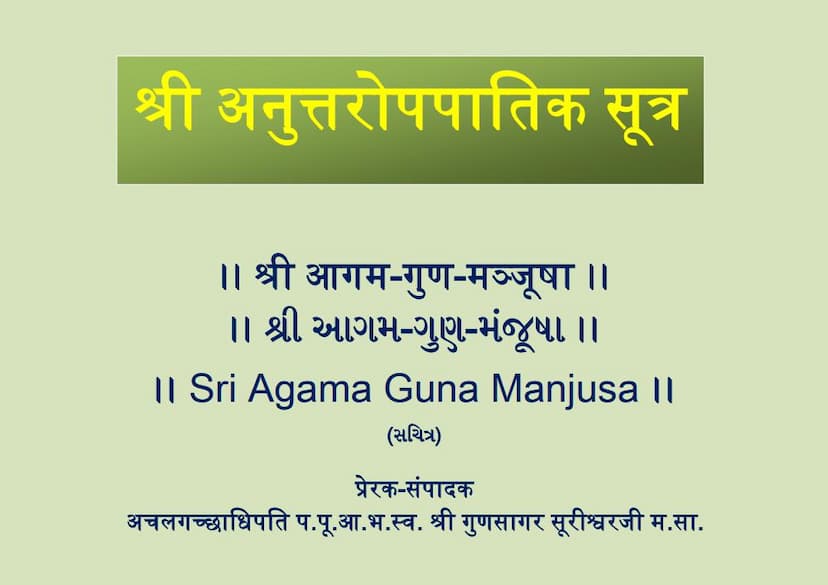Agam 09 Ang 09 Anuttaropapatik Sutra Shwetambar Agam Guna Manjusha
Added to library: September 1, 2025

Summary
This document appears to be a descriptive catalog or overview of various Jain Agamas, specifically focusing on the Śvetāmbara canon. It is presented as part of the "Agam Guna Manjusha" series. The primary text being summarized here is the Anuttaropapātika Sutra (नवम अंग - Ninth Anga).
Here's a breakdown of the information provided, focusing on the Anuttaropapātika Sutra and its context within the broader Agamas:
Overall Context:
- Agam Guna Manjusha: This title suggests a treasury or collection of the virtues and essence of the Agamas.
- Śvetāmbara Agam: The presentation clearly falls within the Śvetāmbara tradition.
- Gunsagarsuri: The "Inspiring Editor" is Achalgachhadhipati P.P. Ā. Bh. Śva. Shri Gunsagarsurishwarji Maharaj.
- 45 Agamas: The document provides a brief introduction to 45 Agamas, divided into categories: Eleven Angas, Twelve Upangas, Ten Payanna Sutras, Six Cheda Sutras, Four Mola Sutras, and Two Chulikas.
Focus on the Anuttaropapātika Sutra:
- Classification: It is identified as the Ninth Anga (नवम अंग) within the 11 Angas.
- Main Subject/Theme: The primary subject is Dharmakathanuyoga (the teaching of religious narratives or stories). It is described as containing life-sketches of great laymen (Mahashravakas) who, after practicing conduct in their final moments, become celestial beings in the Anuttara heavens, and then, in a subsequent birth, take up conduct again and attain liberation.
- Brief Description (Page 2 & 5):
- It is a text of approximately 200 ślokas (verses).
- It details the life stories of those who practice spiritual conduct, reach the Anuttara Vimanas (celestial abodes), and then descend to this world to achieve liberation in their next life. Examples of such individuals include Abhayakumara and nine other princes of King Srenika, Dirghasena and eleven other sons, Dhanna Anagara, etc.
- Detailed Contents (Page 8-15 - Gujarati Text):
- The Anuttaropapātika Sutra is divided into three Vaggas (classes or sections), with a total of 33 Adhyayanas (lessons).
- First Varga: Contains 10 Adhyayanas. The first Adhyayana describes the story of Jāli Kumara, his marriage, renunciation, practice of eleven Angas, penance, 16 years of ascetic life, birth in the Vijaya Anuttara Vimana, and subsequent liberation in Mahavideha. The other Adhyayanas in this section detail the lives of other princes like Mavali, Uvayali, Purisena, Varisena, Dirghadanta, Lastadanta, Vehalla, and Abhaya.
- Second Varga: Contains 13 Adhyayanas. It describes the lives and celestial births of princes like Dirghasena, Mahasena, Lastadanta, Gūdhadanta, Suddhadanta, Malla, Druma, Drumasena, Mahādrumasena, Simha, Simhasena, Mahāsiddhasena, and Punyaseña, who are reborn in various Anuttara Vimanas like Jaya, Vijaya, Jayanta, Aparajita, and Sarvārthasiddha.
- Third Varga: Contains 10 Adhyayanas. This section focuses on individuals like Dhanya, Sunaksatra, Rsidasa, Pellaka, Ramaputra, Chandra, Prsthima, Pendhala, Pottila, and Vehalla, who also attain rebirth in Anuttara heavens after a period of asceticism and eventually achieve liberation. The detailed narrative of Dhanya Anagara is highlighted, including his extreme penance and the divine recognition he receives. The text also emphasizes the specific details of their physical forms after their ascetic practices.
- Anuttara Vimanas: The text explicitly mentions the five Anuttara Vimanas: Jaya, Vijaya, Jayanta, Aparajita, and Sarvārthasiddha.
- Ahamindra: It is stated that in these heavens, there are no distinct Indras; all celestial beings are themselves "Indras" or Ahamindras.
- Lifespan in Anuttara Vimanas: The text indicates specific lifespans in these celestial realms, e.g., thirty-two Sagaropama for some, and thirty-three Sagaropama for others.
- Ultimate Liberation: After their lifespan in the Anuttara Vimanas, these souls are destined to be reborn in Mahavideha and attain liberation (Siddha pada).
- The Anuttaropapātika Sutra is divided into three Vaggas (classes or sections), with a total of 33 Adhyayanas (lessons).
Other Agamas Mentioned Briefly (for context):
The document also provides concise summaries of other key Agamas, categorizing them:
- Eleven Angas: Acārāṅga, Sūtra-kṛtāṅga, Sthānāṅga, Samavāyāṅga, Vyākhyāprajñapti (Bhagavati), Jñātādharmakathāṅga, Upāsakadaśāṅga, Antakṛd-daśāṅga, Anuttaropapātika-daśāṅga, Praśna-vyākaraṇa, Vipāka-sūtra. Each description includes its main theme, number of sections/lessons, and approximate śloka count.
- Twelve Upangas: Oupapātika, Rājapraśnīya, Jīvábhigama, Prajñāpanā, Surya-prajñapti, Chandra-prajñapti, Jambudvīpa-prajñapti, Nirayāvalī, Kalpavatamsaka, Puṣpika, Puṣpacūlikā, Vṛṣṇidaśā.
- Ten Payaṇṇa Sutras: Aurapaccakkhāṇa, Bhattapariṇnā, Sūrya-prajñapti, Chandra-prajñapti (these are also listed as Upangas), Jambūdvīpa-prajñapti (also Upanga), Santhāraka, Tandula-viyāliya, Candavijaya, Devendra-stava, Maraṇasamādhi, Mahāpaccakkhāṇa, Gaṇividyā.
- Six Cheda Sutras: Vyavahāra, Niśītha, Mahāniśītha, Pañc-kalpa, Daśaśruta-skandha, Jita-kalpa. The study of these is described as restricted to highly qualified monks.
- Four Mola Sutras: Daśavaikālika, Uttarādhyayana, Āvaśyaka, Anuయోగdvāra. Āvaśyaka is highlighted as essential for all four sections of the Jain community, outlining daily obligatory duties. Anuయోగdvāra is called the "key to all Agamas."
- Two Chulikas: Nandi Sūtra and Anuయోగdvāra Sūtra (also listed as Mola Sutra).
In essence, the provided text is a guide to understanding the vast Jain Agamas, with a specific focus on detailing the Anuttaropapātika Sutra's content, which narrates the inspiring life journeys of individuals who achieve the highest celestial realms and ultimately attain liberation through rigorous spiritual practice.